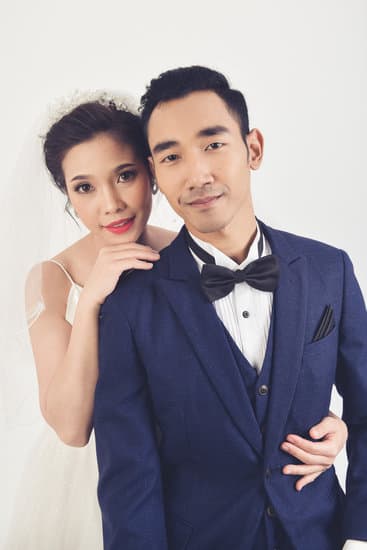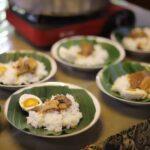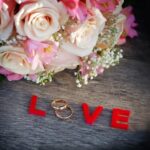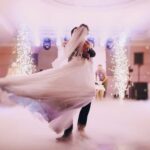When planning your wedding, one of the most crucial decisions you’ll make is choosing the perfect color scheme. The colors you select will set the mood and tone for your special day, reflecting your style and personality as a couple. So, how do you pick wedding colors that will create a memorable and cohesive look for your celebration?
Factors such as personal preferences, venue decor, and overall theme should all be taken into consideration when selecting wedding colors. Whether you’re going for a romantic pastel palette or a bold and vibrant scheme, it’s essential to choose colors that not only complement each other but also enhance the overall ambiance of your event.
Seasonal inspiration can also play a significant role in determining your wedding colors. Different times of the year offer unique opportunities to incorporate seasonal elements into your color palette, adding an extra touch of charm and relevance to your big day. Additionally, considering color psychology can help guide your choice by understanding how different hues can evoke emotions and create specific atmospheres for your guests to enjoy.
Factors to Consider When Choosing Wedding Colors
When it comes to choosing wedding colors, there are several important factors to consider to ensure that your special day reflects your personal style and vision. One of the key considerations is the venue where your wedding will take place.
Take into account the existing décor and color scheme of the venue, as this can influence your choice of wedding colors. For example, if the venue has bold or vibrant colors, you may want to select wedding colors that complement rather than clash with the existing palette.
Another factor to keep in mind is the time of year when your wedding will be held. Different seasons offer unique color palettes that can enhance the overall look and feel of your celebration. For a spring wedding, pastel hues like blush pink, mint green, or lavender are popular choices, while rich jewel tones like emerald green, navy blue, and burgundy work well for fall weddings. Consider how the seasonal elements can inspire the color scheme for your special day.
Additionally, think about your own personal preferences and style when choosing wedding colors. Do you lean towards bright and bold hues or prefer a more muted and romantic color palette? Your wedding colors should reflect your personality as a couple and create a cohesive look throughout all aspects of your celebration. Don’t be afraid to think outside the box and choose colors that speak to you both as individuals and as a couple.
Seasonal Inspiration
Choosing the perfect wedding colors is a crucial decision that sets the tone and ambiance for your special day. When it comes to selecting the right color palette, one important factor to consider is the time of year in which your wedding will take place. Seasonal inspiration can play a significant role in guiding you towards the colors that will best complement the time of year and enhance the overall look and feel of your celebration.
For a spring wedding, pastel hues like soft pink, lavender, mint green, and peach are popular choices that reflect the blooming flowers and fresh beginnings associated with this season. These light and airy colors can create a romantic and whimsical atmosphere for your ceremony and reception. Summer weddings often embrace bright and bold colors such as coral, turquoise, yellow, and tropical shades inspired by beach destinations. These vibrant hues can add energy and warmth to your summer celebration.
As autumn approaches, earthy tones like burnt orange, deep red, mustard yellow, and rich burgundy are commonly chosen to capture the cozy and rustic feel of the season. These warm shades can create a sense of comfort and elegance for an autumn wedding.
For winter weddings, classic color choices include navy blue, emerald green, silver, gold, and icy blues to evoke a sense of sophistication and glamour fitting for this festive time of year. By aligning your wedding color palette with the seasonal characteristics and aesthetics, you can create a cohesive look that complements the natural surroundings and enhances the overall ambiance of your special day.
Color Psychology
Choosing the perfect wedding colors goes beyond simply picking your favorite hues. The colors you choose can have a significant impact on the overall look and feel of your big day. This is where color psychology comes into play. Different colors have the power to evoke certain emotions and set the tone for your wedding.
For instance, red is often associated with passion, love, and energy, making it a popular choice for romantic weddings. On the other hand, blue is known for its calming and serene qualities, making it ideal for couples looking to create a peaceful atmosphere. By understanding the emotional impact of various colors, you can select hues that align with the mood you want to create on your special day.
When considering color psychology for your wedding, think about how you want your guests to feel throughout the event. Do you want them to feel energized and joyful? Opt for bright and vibrant colors like yellow or orange.
Or perhaps you prefer a more sophisticated and elegant ambiance – in this case, classic shades like navy blue or emerald green may be more suitable. By using color psychology as a guide, you can create a cohesive color scheme that not only looks beautiful but also resonates emotionally with everyone in attendance.
Trends in Wedding Colors for the Current Year
When it comes to selecting the perfect colors for your wedding, staying updated on the latest trends can provide valuable inspiration. For couples planning their special day in the current year, there are several popular color palettes making waves in the wedding industry.
One of the prominent trends this year is incorporating shades of green into wedding color schemes. Whether it’s a soft sage or a deep emerald, green hues can add a touch of elegance and natural beauty to any wedding.
Another trend that has been gaining popularity is the use of pastel tones in wedding colors. Soft and subtle pastel shades like blush pink, lavender, and light blue are versatile choices that can create a romantic and dreamy atmosphere for your big day. These gentle colors are perfect for couples looking to achieve a delicate and whimsical aesthetic in their wedding decor.
Furthermore, modern couples are also gravitating towards bold and vibrant color combinations for their weddings this year. From striking jewel tones like sapphire blue and ruby red to energetic citrus hues like tangerine and lemon yellow, incorporating bright colors can make a statement and infuse your celebration with energy and cheerfulness. Mixing these daring shades together can result in a visually stunning and unforgettable color palette for your wedding day.
| Color Trend | Description |
|---|---|
| Shades of Green | Add elegance and natural beauty to your wedding. |
| Pastel Tones | Create a romantic and dreamy atmosphere with soft colors. |
| Bold & Vibrant Colors | Make a statement with striking jewel tones or energetic citrus hues. |
How to Create a Color Palette That Complements Your Wedding Theme
Choosing the perfect color palette for your wedding can be a daunting task, but it is essential to create a cohesive and visually appealing aesthetic for your big day. When deciding on wedding colors, it is crucial to consider how they will complement your overall wedding theme. Here are some factors to keep in mind when creating a color palette that perfectly fits your wedding theme:
- Consider the venue: Think about the colors of your venue space and how you can incorporate them into your color palette. Whether you are getting married in a rustic barn, a modern loft, or a beachside resort, choosing colors that complement the existing decor will create a harmonious look.
- Take inspiration from your wedding theme: If you have chosen a specific theme for your wedding, such as vintage, bohemian, or romantic garden, use elements of that theme to inspire your color choices. For example, if you are having a vintage-inspired wedding, consider incorporating muted pastels and antique gold for a timeless look.
- Don’t be afraid to mix textures and shades: When creating a color palette, don’t limit yourself to just one or two colors. Experiment with different shades within the same color family or combine complementary colors for added depth and visual interest. Mixing textures like velvet, silk, or metallics can also add dimension to your color scheme.
By carefully considering these factors and taking inspiration from your wedding theme, you can create a color palette that complements every aspect of your special day. Whether you opt for soft pastels for a romantic feel or bold jewel tones for a more dramatic look, choosing the right colors will set the tone for your entire wedding celebration.
Tips for Incorporating Multiple Colors Into Your Wedding Color Scheme
When it comes to choosing wedding colors, incorporating multiple colors into your color scheme can add depth, dimension, and a unique touch to your special day. However, it can be challenging to strike the right balance and avoid a chaotic or overwhelming look. Here are some tips on how to successfully incorporate multiple colors into your wedding color scheme.
Consider a Main Color Palette
Start by choosing a main color palette that will serve as the foundation for your wedding design. This main color palette should include 2-3 primary colors that work well together and reflect the overall vibe you want for your wedding. Once you have established these main colors, you can then add in accent colors to complement and enhance the overall look.
Utilize Different Shades and Tones
Incorporating multiple colors doesn’t always mean using completely different hues. You can create a cohesive look by incorporating different shades and tones of the same color family. For example, if your main color is blue, you can include lighter shades like baby blue or darker tones like navy blue to add variety without straying too far from the initial color palette.
Balance Bold Colors With Neutrals
If you plan on including bold and vibrant colors in your wedding color scheme, consider balancing them out with neutral tones like white, ivory, beige, or gray. Neutrals can help tone down the intensity of bright colors and create a more polished and sophisticated look. Finding the right balance between bold shades and neutrals will ensure that all of your chosen colors work harmoniously together on your big day.
Incorporating multiple colors into your wedding color scheme requires careful planning and consideration. By following these tips and ensuring that all of your chosen colors complement each other well, you can create a visually stunning and cohesive wedding design that reflects your unique style and personality.
Real Wedding Examples
When it comes to selecting wedding colors, inspiration can be found in real-life examples of beautifully executed color combinations. Looking at real wedding examples can provide valuable insights and ideas for your own special day. These showcases can serve as a source of inspiration, helping you visualize how different colors can be combined to create a cohesive and stunning color palette.
Classic Elegance
One timeless color combination that never goes out of style is navy blue and gold. This elegant pairing exudes sophistication and glamour, perfect for a formal wedding affair. Imagine navy blue bridesmaid dresses accented with gold accessories, complemented by gold table settings and decor. Real wedding examples showcasing this classic combination demonstrate how the rich hues can create a luxurious ambiance that guests will surely remember.
Rustic Charm
For couples planning a rustic-themed wedding, earthy tones like sage green, blush pink, and ivory are popular choices. These soft and romantic colors evoke a sense of nature and simplicity, ideal for an outdoor or barn venue. Real wedding examples featuring this color palette often include natural elements like wooden accents, greenery, and soft floral arrangements. Seeing how these colors come together in real weddings can inspire you to incorporate similar elements into your own rustic celebration.
Modern Twist
If you’re drawn to more contemporary styles, consider bold and vibrant color combinations like emerald green and deep purple. These rich jewel tones make a statement and add a modern flair to your wedding decor.
Real wedding examples showcasing this daring pairing often feature sleek lines, geometric shapes, and metallic accents. By studying how these colors are used in real weddings, you can gain insight on how to infuse your personal style into your special day while still maintaining a cohesive look.
By exploring real wedding examples with different color combinations, you can gather ideas on how to bring your vision to life with the perfect palette for your big day. Whether you prefer classic elegance, rustic charm, or modern twists on traditional hues – there’s inspiration out there waiting for you.
Final Thoughts
Choosing the perfect wedding colors can be both an exciting and daunting task. It sets the tone for your special day, reflects your personal style, and creates a cohesive look for all the elements of your wedding.
While there are countless factors to consider when deciding on your color scheme, one thing remains certain – it should be a reflection of you as a couple. So, how do you pick wedding colors that truly resonate with you and create the ambiance you desire?
First and foremost, consider what emotions you want to evoke on your wedding day. Different colors have unique psychological effects and can influence the mood of your celebration. Whether you opt for vibrant hues to create a lively atmosphere or pastel shades for a more romantic feel, understanding color psychology can help guide your decision-making process.
Furthermore, take into account the season in which you will be tying the knot. Seasonal inspiration can play a significant role in determining your wedding colors. For example, soft blush tones may be perfect for a spring wedding, while rich jewel tones work beautifully in the fall. Let nature’s palette guide you as you select colors that will harmonize with the surroundings of your chosen wedding date.
In conclusion, creating a color palette that complements your wedding theme is essential in bringing all aspects of your big day together seamlessly. Remember to trust your instincts, choose colors that make you both happy, and don’t be afraid to think outside the box. Your wedding colors should reflect who you are as individuals and as a couple – so let them speak volumes about your love story on this unforgettable day.
Frequently Asked Questions
How Do People Pick Wedding Colors?
When choosing wedding colors, people often consider various factors such as personal preferences, the season of the wedding, venue decor, cultural significance, and trends. Some couples opt for their favorite colors or hues that hold sentimental value to them, while others may select colors that complement the overall theme or style of their celebration.
How Do I Find My Wedding Color Palette?
To find your perfect wedding color palette, start by considering your personal style and preferences. Look to sources of inspiration such as nature, fashion trends, interior design, and art for ideas.
It’s important to think about the mood you want to create on your big day – whether you prefer soft and romantic tones or bold and vibrant shades. Experiment by creating mood boards or using online tools to visualize different color combinations until you find one that resonates with you.
What Color Should My Wedding Be?
The color of your wedding should ultimately reflect your unique personality as a couple and set the tone for the celebration. Consider factors such as the season in which your wedding will take place, the venue’s aesthetic, and any cultural or traditional elements you want to incorporate.
Whether you choose a classic white wedding with subtle accents or a colorful extravaganza filled with bright hues, make sure the colors you select represent who you are as a couple and create a cohesive look throughout your day.

I have been involved in marriages for over 20 years helping couples and singles understand more about them.





